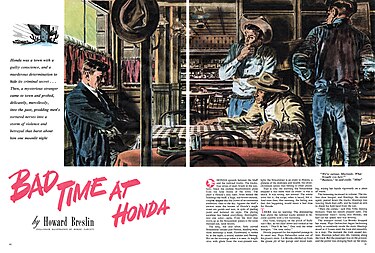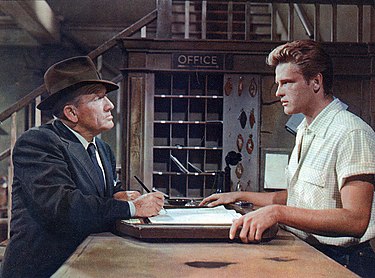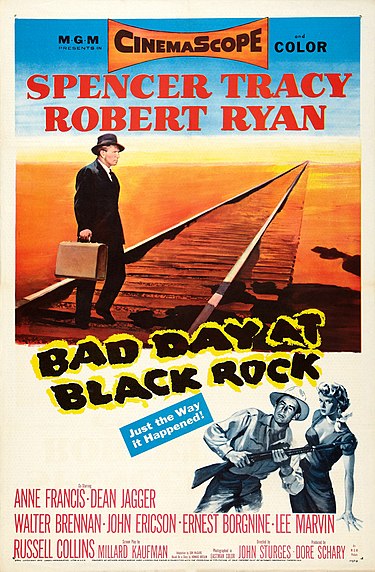Bad Day at Black Rock
Bad Day at Black Rock is a 1955 American neo-western movie with a runtime of 81 minutes. Distributed by MGM, it is a Dore Schary production directed by John Sturges. The screenplay is based on Bad Time at Honda, a 1947 short story by Howard Breslin which was published in The American Magazine. The original screenplay was written by Millard Kaufman, later adapted by Don McGuire.
Filming began in July 1954 and the film went on national release in America on 7 January 1955. It was a box office success, grossing $3,788,000 over a budget of $1,288,000, and was nominated in three categories at the 28th Academy Awards in 1956. In 2018, it was selected for preservation in the United States National Film Registry.
The film stars Spencer Tracy and Robert Ryan with support from Anne Francis, Dean Jagger, Walter Brennan, John Ericson, Ernest Borgnine, Lee Marvin and Russell Collins. The cinematography was by William C. Mellor, editing by Newell P. Kimlin and the music by André Previn. The cast was small but included three past (Brennan, Jagger, Tracy) and two future (Borgnine, Marvin) Academy Award winners, one past Academy Award nominee (Ryan), and one future Golden Globe winner (Francis).
The setting is a remote location in the Arizona desert where a small town called Black Rock has a seldom-used railway halt. Although the film is a crime drama set in 1945 just after the end of the Second World War, it is in effect a revisionist western. The plot concerns a one-armed stranger (Tracy) who arrives by rail and uncovers an evil secret that has corrupted the entire community.

Cast
| character | played by |
| John J. Macreedy | Spencer Tracy |
| Reno Smith | Robert Ryan |
| Liz Wirth | Anne Francis |
| Sheriff Tim Horn | Dean Jagger |
| Doc Velie | Walter Brennan |
| Pete Wirth | John Ericson |
| Coley Trimble | Ernest Borgnine |
| Hector David | Lee Marvin |
| Mr Hastings | Russell Collins |
| Sam, the diner owner | Walter Sande |
| Train conductor | Harry Harvey |
| Porter | Bobby Johnson |
Walter Brennan (1936, 1938, 1940), Dean Jagger (1950) and Spencer Tracy (1938, 1939) had all won Academy Awards and Robert Ryan (1948) had been nominated for one. In later years, Ernest Borgnine (1956) and Lee Marvin (1965) both won Academy Awards and Anne Francis (1965) won a Golden Globe.
Production
Bad Day at Black Rock originated as a short story by Howard Breslin with full-color illustrations by Robert Fawcett. Entitled Bad Time at Honda, it was published by The American Magazine in January 1947. It was adapted into a script by Don McGuire and pitched to MGM production head Dore Schary, who was known for championing films that addressed social problems. Schary had previously produced Go for Broke! (1951), based on the exploits of the segregated Japanese-American 442nd Infantry Regiment.
Schary acquired the film rights for MGM, but he brought in Millard Kaufman to rewrite McGuire's script. The producers were worried about the title because Bad Time at Honda was similar to Hondo, recently made by John Wayne. Kaufman suggested changing the name of the town to Black Rock, after a real town in Arizona. Kaufman finished the script in the fall of 1953. Although Spencer Tracy was 55 and much older than the platoon leader in the original story, Schary wanted Tracy to play the lead role. John Sturges was hired as director in June 1954 and shooting began the following month near Lone Pine, California, where the small town set had been quickly constructed. Just before shooting began, an indecisive Tracy tried to back out of the picture. Schary made clear that he was willing to sue the actor if he quit the film. Budget was $1.3 million and it was shot in colour using Cinemascope as Schary thought widescreen would emphasise the menace of the isolated town. Temperatures on location were over 100°F. On August 9, the cast and crew moved to the studio lot in Culver City. André Previn was hired to write the score.
The premiere was at Loew's 72nd Street Theater in New York City on 8 December 1954. The film went on national release 7 January 1955. According to MGM records, it earned $1,966,000 in the US and Canada and $1,822,000 elsewhere, making the studio a profit of $947,000.
Plot
In late 1945, one-armed John J. Macreedy gets off a train at the isolated desert hamlet of Black Rock. The residents immediately appear suspicious, as this is the first time in four years that the train has stopped there. After Macreedy states he is looking for a man named Komoko, several of the local men become hostile. Hastings, the telegraph agent, tells him there are no cabs; the hotel desk clerk, Pete Wirth, claims he has no vacant rooms. Hector David threatens him. Later, Reno Smith informs Macreedy that Komoko, a Japanese-American, was interned during World War II.
Macreedy visits the local sheriff, Tim Horn, but the alcoholic lawman is of no help. The veterinarian and undertaker, Doc Velie, advises Macreedy to leave town immediately, but lets slip that Komoko is dead. Pete's sister Liz rents Macreedy a Jeep. He drives to nearby Adobe Flat, where he finds a homestead burned to the ground, and wildflowers growing nearby. As Macreedy drives back, Coley Trimble tries to run him off the road. Macreedy tries to leave town, but Liz, having been confronted by Smith earlier, refuses to rent him the Jeep again. When Smith asks about his lost left arm, Macreedy discloses that he lost it fighting in Italy. Macreedy says the wildflowers at the Komoko place lead him to suspect that a body is buried there. Smith reveals that he is virulently anti-Japanese; he tried to enlist the day after the attack on Pearl Harbor, but failed the physical.
Macreedy tries to telephone the state police, but Pete refuses to put the call through. Doc Velie admits that something terrible happened four years ago, but Smith has everyone too terrified to speak up. Velie offers Macreedy his old hearse to leave town, but Hector disables it. Macreedy writes a telegram to the state police and gives it to Hastings. Macreedy goes to the diner where Trimble provokes a fight with him but Macreedy, though disabled, easily beats him up by using martial arts. Macreedy confronts Smith and accuses him of killing Komoko with the help of others. Hastings arrives and tries to give Smith a piece of paper, but Macreedy snatches it away. It is his unsent telegram. Macreedy and Velie tell Hastings he has broken the law and demand that Horn take action. Horn stands up to arrest Hastings, but Smith pulls the sheriff's badge off Horn's shirt and pins it on Hector, who casually tears up the telegram.
After Smith and Hector leave, Macreedy reveals that the loss of his arm had left him wallowing in self-pity, but Trimble's attempt to kill him has reinvigorated him. Macreedy finally reveals that Komoko's son died in combat (with the 442nd Infantry Regiment) while saving his life. Macreedy came to town intending to give the man's medal to Komoko. Macreedy learns that the elder Komoko had leased some farmland from Smith, who was sure there was no water. Komoko dug a well and found water. After Smith was rejected for military service, he and the other men got to drinking, then decided to scare Komoko. The old man barricaded himself inside his home, but the men set it on fire. When Komoko emerged ablaze, Smith shot and killed him.
Doc and Pete enlist Liz to help Macreedy escape under cover of darkness. Hector is standing guard outside the hotel; Pete lures him into the office, where Doc Velie knocks him unconscious. Liz drives Macreedy out of town, but stops at Adobe Flat. Macreedy realizes he has been set up. When Smith starts shooting at him, Macreedy shelters behind the Jeep. Liz rushes to Smith despite Macreedy's warning. Smith tells her that she has to die along with the rest of his accomplices. Smith shoots her in the back as she flees. Macreedy finds a bottle and fills it with gas from the Jeep. When Smith climbs down for a better shot, Macreedy throws the Molotov cocktail, setting Smith on fire. Macreedy drives back to town with Smith and Liz's body. The state police are called in and several arrests are made. As Macreedy is leaving town, Doc Velie requests Komoko's medal to help Black Rock heal. Macreedy gives it to him just before boarding the train.
Themes
Though essentially a neo-western crime drama with revisionist overtones, the film is one of the first to recognise discrimination against Japanese Americans in World War II. No Japanese American characters are portrayed though Komoko and his son, both dead, are central to the plot. In her 1991 documentary film, History and Memory: For Akiko and Takashige, Rea Tajiri uses footage from Bad Day at Black Rock to illustrate prevailing attitudes towards the Japanese. Tajiri's family were among those interned after the attack on Pearl Harbor.
In his American Studies essay, John Streamas describes the film as an indictment of both racism and McCarthyism. He comments on the unusual means of denunciation that it employs because, with no Japanese American characters taking part, there is no liberation of an oppressed victim. Instead, the film delivers justice for the victim of a murder committed four years earlier.
Critical response
When Bad Day at Black Rock was released, the reviews were almost universally positive with, for example, John O'Hara in Collier's hailing it as "one of the finest motion pictures ever made".[1] Many reviewers noted the film's western-like elements, comparing it favorably with High Noon and cinematographer William C. Mellor was widely praised for his use of widescreen. Film critic Bosley Crowther of the New York Times wrote: "Slowly, through a process of guarded discourse, which director John Sturges has built up by patient, methodical pacing, an eerie light begins to glimmer".[2] At the end of 1955, the New York Times included the film in its best ten of the year.
Despite a storyline she called "crudely melodramatic", Pauline Kael heaped praise on the film for its direction and cinematography, calling it "a very superior example of motion picture craftsmanship".[3] Variety magazine's reviewer wrote: "Considerable excitement is whipped up in this suspense drama, and fans who go for tight action will find it entirely satisfactory. Besides telling a yarn of tense suspense, the picture is concerned with a social message on civic complacency".[4]
Awards and legacy
Bad Day at Black Rock was nominated in three categories at the 28th Academy Awards in 1956: Tracy for best actor, Sturges for best director, and Kaufman for best screenplay. None of them won. Ironically, the best actor award went to Ernest Borgnine for his performance in Marty, his next film after Bad Day at Black Rock. Tracy won the best actor award at the 1955 Cannes Film Festival. In 2018, Bad Day at Black Rock was selected by the Library of Congress for preservation in the United States National Film Registry. It was cited as being "culturally, historically, or aesthetically significant".

